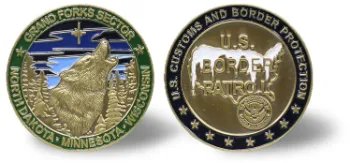The Grand Forks Sector is responsible for 861 miles of international border located along the northern portions of North Dakota (ND) and Minnesota (MN), of which 403 is land border and 458 is water boundary. Over 200 Border Patrol agents are permanently assigned to eight stations within the Sector.
Six line stations patrol this boundary and are located in Portal, Bottineau, and Pembina, ND, as well as Warroad, International Falls, and Grand Marais, MN. Two back-up stations provide defense-in-depth support and are located in Grand Forks, ND and Duluth, MN. Grand Forks Sector also has the Resident Agent Program (RAP). A Resident Agent (RA) is an agent who is assigned to one of Grand Forks Sector's eight Border Patrol Stations, but lives and works at an assigned location away from the station. The RAP was conceptualized to develop and maintain full situational awareness within the Grand Forks Sector area of responsibility.
In support of the Border Patrol's National Strategy, Grand Forks Sector applies an approach to broaden the border while utilizing the principals of the Northern Border Resourcing Philosophy. The Sector conducts targeted threat-based enforcement efforts with our Canadian law enforcement counterparts through the Integrated Border Enforcement Teams (IBETs); provides strong defense-in-depth deployment of resources through the implementation of the RAP at 12 strategic locations throughout the area of operations; coordinates strong partnerships with federal, state, local and tribal law enforcement agencies through the utilization of enforcement-based funding from Operation Stonegarden to directly support border security missions; and employs targeted air patrols in collaboration with Office of Air and Marine - North Dakota Air Branch.
History
Shortly after the founding of the U.S. Border Patrol in 1924, the area now encompassed by the Grand Forks Sector contained three separate Border Patrol Sectors. These three Border Patrol Sector Headquarters were established at Duluth, MN, International Falls, MN, and Portal, ND. There was much reorganization of these three Sectors until Grand Forks was finally designated as a Sector Headquarters in October of 1939. During this reorganization period, an additional sector headquarters was added, and then subsequently removed, from Portal, ND.
The Grand Forks Sector Challenge Coin was designed to capture some of the unique and distinguishing characteristics of the north. The design of the coin represents both North Dakota and Minnesota, and depicts the North Star (Polaris) and the Northern Lights (Aurora Borealis).
The Gray Wolf, also known as the Timber Wolf, was once plentiful in most of North America, but today survives in only three percent of its original home range. By the time the Gray Wolf was protected by the Endangered Species Act of 1973, it had been exterminated from the lower 48 states, except for a few hundred that inhabited northeastern Minnesota. Today, about 3,000 Gray Wolves live in the wild in Minnesota and with the population increase, individual wolves are dispersing into neighboring states. Approximately 400 wolves live in northern Wisconsin and an occasional wolf is sighted in North Dakota.


